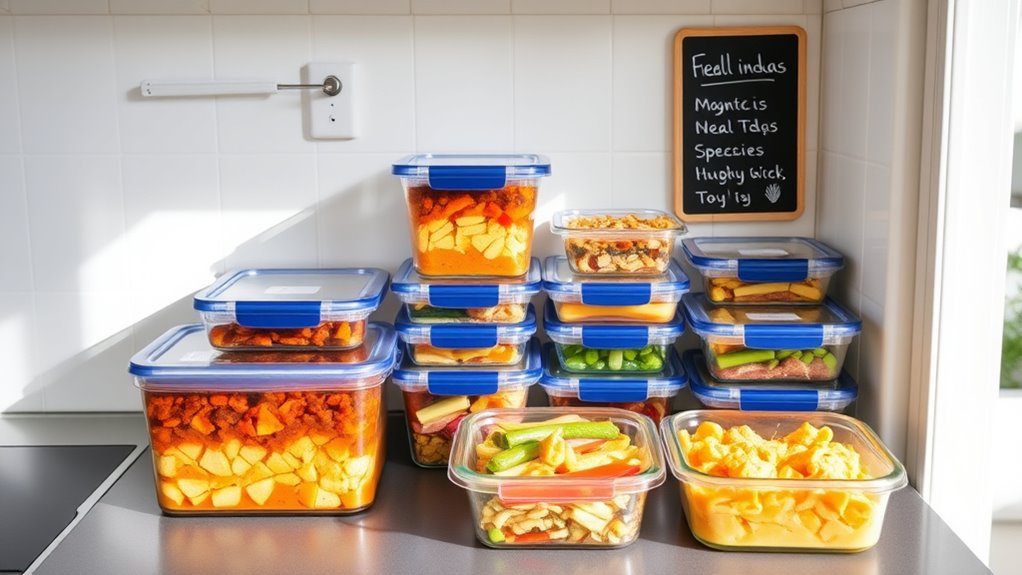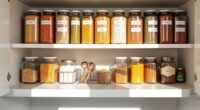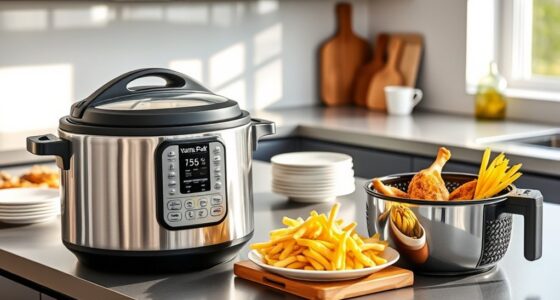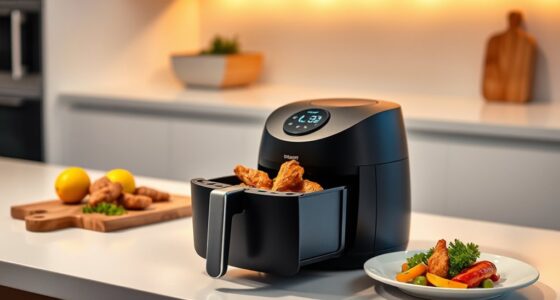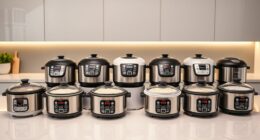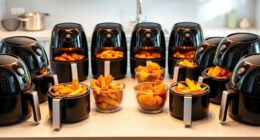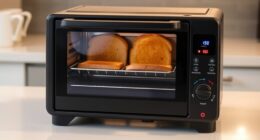In small kitchens, freezer-friendly meal planning helps you save time, reduce waste, and stay organized. Focus on batching recipes like casseroles, soups, and breakfasts that freeze well, using the right containers and labels. Properly portion meals and reheating techniques keep flavors fresh. Clear organization and smart storage maximize limited space. If you want practical tips and delicious recipes to make the most of your freezer, keep exploring these helpful strategies to streamline your meal prep.
Key Takeaways
- Utilize freezer-friendly recipes like egg muffins, burritos, and pancakes for quick, bulk meal prep suitable for small kitchens.
- Invest in proper containers and labeling tools to maximize freezer organization and food freshness.
- Plan weekly meal prep sessions, batch shop, and pre-prep ingredients to save time and reduce clutter.
- Portion meals into single servings, use airtight containers, and follow safe reheating practices to maintain quality.
- Organize freezer space with clear bins and labels, and thaw meals safely to ensure food safety and convenience.
Benefits of Freezing Meals for Small Kitchens

Freezing meals offers significant advantages for small kitchens where space and time are limited. It streamlines your meal prep, allowing you to cook in bulk and store individual portions for later. This approach minimizes daily cooking, saving you precious time during busy weekdays. Plus, freezing is a smart food preservation method that helps prevent waste by extending the shelf life of leftovers and bulk ingredients. You can prepare and freeze meals in advance, so you always have nutritious options ready to heat and serve. Incorporating meal organization strategies can further optimize your freezer space and improve overall efficiency. This not only reduces clutter in your small kitchen but also guarantees you’re never caught short without a homemade meal. Embracing freezer cooking makes small kitchens more efficient, helping you stay organized while enjoying fresh, homemade food every day.
Essential Tools and Containers for Freezer Cooking

To make freezer cooking efficient and hassle-free, having the right tools and containers is key. Reusable containers, like BPA-free plastic or glass jars, are great for storing individual portions and reducing waste. They stack easily, saving space, and are durable enough for repeated use. Vacuum sealers are another essential tool; they remove air from bags, preventing freezer burn and extending shelf life. Using vacuum-sealed bags is especially helpful for bulk items or delicate foods like berries and cooked meats. Invest in a variety of sizes to accommodate different recipes and portion sizes. Proper containers and sealing tools make stacking, organizing, and accessing your meals quick and simple, ensuring your freezer stays organized and your meals stay fresh longer. Additionally, selecting appropriate storage options supports maintaining food quality and prolongs shelf life in your freezer.
Planning Your Weekly Freezer Meal Strategy

Creating an effective weekly freezer meal strategy starts with planning ahead to save time and reduce stress during busy days. Begin by scheduling meal prep sessions that fit your weekly routine, focusing on recipes that freeze well. Use shopping tips like making a detailed grocery list based on your meal plan to avoid impulse buys and multiple trips. Batch your shopping to save time and guarantee you have all ingredients on hand. Consider prepping ingredients in advance—chopping vegetables or cooking grains—so assembling freezer meals becomes quick and straightforward. By mapping out your week’s meals and sticking to your shopping list, you’ll streamline your freezer cooking process, minimize waste, and assure you always have healthy, homemade options ready to go when life gets hectic. Incorporating freezer-friendly recipes that are designed to retain quality after freezing can further enhance your meal planning success.
Breakfasts That Freeze Well and Save Time

Freezing breakfasts like make-ahead egg muffins, breakfast burritos, and pancakes can save you time on busy mornings. These options are easy to prepare in advance and quickly heat up when you’re in a rush. Let’s explore how to make and store these meals for maximum freshness and convenience. Incorporating proper food handling techniques can help maintain the quality and safety of your frozen breakfasts.
Make-Ahead Egg Muffins
Make-ahead egg muffins are a quick and convenient breakfast option that can save you time during busy mornings. You can customize them with various egg muffin variations, adding vegetables, cheese, or meats to suit your taste. When preparing, use muffin container tips like greasing or lining to prevent sticking. These muffins freeze well, so you can batch cook for the week and reheat effortlessly. Imagine grabbing a warm, protein-packed breakfast in minutes—no rush, no fuss. Feel confident knowing you have a nutritious start ready to go. Plus, making them in advance reduces morning stress and helps you stick to healthy choices. With these simple strategies, breakfast becomes a breeze, even on the busiest days. Additionally, using specialized containers can help maintain the muffins’ shape and freshness during storage.
Freezing Breakfast Burritos
Preparing breakfast burritos in advance is a smart way to streamline your mornings and guarantee you start the day with a nutritious meal. These burritos are excellent for meal prep strategies because they freeze well and can be customized to your tastes. To make them, fill whole wheat tortillas with scrambled eggs, cooked sausage or bacon, cheese, and veggies. For ingredient substitutions, try spinach instead of peppers or turkey sausage instead of pork. Wrap each burrito tightly in foil or plastic wrap and freeze. When ready to eat, simply microwave for 2–3 minutes until hot. This method saves time and reduces morning stress, giving you a healthy, satisfying breakfast on busy days. Freezing breakfast burritos is a versatile, convenient option for small kitchens. Affiliate relationships are disclosed to ensure transparency with consumers.
Pancakes for Busy Mornings
Having breakfast ready to go can make hectic mornings much easier, especially when you need a quick, satisfying meal. Freezing pancake variations allows you to enjoy warm, fluffy pancakes anytime, without the morning rush. Simply prepare a batch, let them cool, and store in an airtight container. When you’re ready to eat, just reheat in the microwave or toaster. To keep things exciting, experiment with different breakfast toppings like fresh berries, nut butters, or a drizzle of honey. You can also try adding mix-ins to the batter, such as chocolate chips or blueberries, for variety. These freezer-friendly pancakes make busy mornings smoother, giving you more time to focus on what matters. Plus, they’re perfect for customizing to suit everyone’s favorite pancake variations. To ensure your pancakes stay fresh longer, consider storage tips such as using airtight containers or freezing in portioned amounts.
Lunch and Dinner Recipes Perfect for Freezing

Freezing lunch and dinner recipes saves you time and guarantees you always have a homemade meal ready to go. To get the best results, focus on make-ahead freezer meals, proper portioning, and storage techniques that maintain flavor and texture. When reheating, use the right methods to serve your meals fresh and delicious every time. Incorporating proper storage techniques ensures that your meals retain their quality and nutritional value over time.
Make-Ahead Freezer Meals
Making ahead freezer meals is a smart way to save time and reduce stress during busy days. With effective meal prep strategies, you can prepare large batches of lunch or dinner that stay fresh and delicious in your freezer. These meals offer convenience and peace of mind, especially when quick solutions are needed. Remember to follow freezer safety tips, like cooling foods properly before freezing and labeling containers clearly. This guarantees your meals stay safe and flavorful. Imagine opening your freezer and grabbing a homemade lasagna, chili, or stir-fry with ease. Feel confident knowing you’re reducing waste and making nutritious choices even on hectic days. Freezing options like Honda Tuning can inspire you to customize recipes for better flavor and performance. Freeze, reheat, and enjoy — it’s that simple to streamline your kitchen routine and enjoy home-cooked meals anytime.
Portioning and Storage Tips
Proper portioning and storage are essential to guarantee your freezer meals stay fresh and easy to reheat. Using portion control helps prevent waste and makes it simple to grab exactly what you need. Invest in the right container selection—choose airtight, freezer-safe containers or resealable bags that prevent leaks and preserve flavor. When portioning, consider dividing meals into single servings to streamline mealtime and avoid refreezing leftovers multiple times. Label each container with the date and contents so you can track freshness easily. Leave a little space at the top of containers to allow for expansion during freezing. Properly portioned and stored meals stay flavorful and maintain quality, making your freezer a reliable resource for quick, delicious lunches and dinners.
Reheating and Serving
Reheating and serving frozen meals doesn’t have to be complicated if you choose the right recipes and methods. Focus on microwave safety to ensure your meals heat evenly and stay safe to eat. When reheating, stir or rotate food midway to prevent cold spots and ensure thorough heating. For serving suggestions, consider garnishing with fresh herbs or a squeeze of lemon to brighten flavors. Proper reheating preserves texture and taste, making your frozen meals feel fresh. Use microwave-safe containers to avoid spills or accidents. Always check that dishes reach the proper internal temperature before eating. With these tips, you’ll enjoy hot, flavorful meals quickly and confidently—saving time without sacrificing quality. Your small kitchen can produce big, satisfying results every day.
Tips for Properly Packaging and Labeling Your Meals

To guarantee your meals stay fresh and easy to identify, it’s essential to pack and label them correctly. Focus on meal presentation by choosing airtight containers that prevent freezer burn and keep flavors intact. Use clear, durable packaging that’s easy to stack and organize. When labeling, include the meal name, date of preparation, and any reheating instructions. Employ effective labeling strategies, like waterproof markers or labels, to prevent smudging. Keep labels visible so you can quickly locate meals and monitor freshness. Proper packaging not only preserves taste but also makes meal planning more efficient. Consistent labeling helps you avoid confusion and reduces waste. Considering storage tips can further enhance your freezer organization and meal quality. By paying attention to meal presentation and labeling strategies, you ensure your freezer stays organized and your meals remain delicious.
Thawing and Reheating Techniques to Preserve Flavor

After packaging and labeling your meals carefully, the next step is to thaw and reheat them without sacrificing flavor or texture. To guarantee thawing safety, always plan ahead and thaw in the refrigerator or use the defrost setting on your microwave. When reheating, focus on preserving reheating flavors by stirring gently and avoiding overheating, which can dry out your food. Proper techniques help maintain the meal’s original taste and freshness. Additionally, being mindful of food safety practices during thawing and reheating ensures your meals stay safe to eat and retain their quality.
Organizing Your Freezer Space Efficiently

Organizing your freezer efficiently guarantees you can access your meals quickly and prevent waste. Start by using clear bins or containers to group similar items, which improves freezer organization and makes it easier to find what you need. Label everything with dates to ensure proper storage optimization and to avoid forgotten foods. Arrange items by size and frequency of use, placing everyday staples at the front for quick access. Stack containers neatly to maximize space, and consider using stackable shelves or baskets for better organization. Keep a list of frozen items on the freezer door to track what you have, reducing unnecessary opening and closing. Incorporating performance cookies to analyze your storage patterns can help further optimize your freezer management. With a well-organized freezer, you’ll save time, reduce food waste, and streamline your meal prep routine.
Creative Ways to Incorporate Frozen Meals Into Your Routine

Incorporating frozen meals into your routine can be both convenient and nutritious when you get creative with your approach. You can transform simple dishes into exciting, flavorful meals by experimenting with creative meal combinations and adding flavorful spice blends. For example, toss frozen chicken into a stir-fry with fresh vegetables and a bold sauce, or layer frozen fish with herbs and citrus for a quick bake. Use different spices to elevate flavors effortlessly. To inspire you, consider these ideas:
- Mix frozen grains with roasted veggies and a splash of tahini
- Top frozen soups with fresh herbs and crusty bread
- Incorporate frozen meats into wraps with vibrant sauces
- Add a dash of spices to frozen vegetables before roasting
- Combine frozen fruit with yogurt for a quick dessert
- Regularly assessing and rotating your frozen items aligns with space maximization strategies, helping you maintain an organized freezer and reduce waste.
Get inventive—your freezer is a treasure trove of possibilities.
Frequently Asked Questions
How Long Can Frozen Meals Be Stored Safely in a Small Freezer?
You might wonder about the freezer lifespan and storage duration for frozen meals. In general, most cooked dishes stay safe for 2 to 3 months in a small freezer, but quality can decline over time. To maximize freshness, label your meals with dates. Keep your freezer at 0°F (-18°C), and avoid overstuffing it. Regularly check for signs of freezer burn or spoilage to guarantee safety and taste.
Are There Specific Recipes That Freeze Better Than Others?
Think of some recipes as a well-oiled machine, perfect for freezing. You’ll find that dishes with freezing vegetables, hearty stews, and casseroles freeze better because they maintain flavor and texture. For best results, follow reheating tips to prevent sogginess or dryness. These recipes are your allies, making meal prep easier, saving space, and ensuring your frozen meals taste fresh even after months in the freezer.
Can I Freeze Meals Prepared in Advance Without Affecting Taste?
You can freeze meals prepared in advance without affecting taste if you plan your meal prep carefully. Use ingredient swaps that freeze well, like sturdy vegetables and proteins, and avoid ingredients that lose texture, such as potatoes or dairy. Store meals in airtight containers to prevent freezer burn. Properly cooled and sealed, your frozen meals will taste just as good when you reheat, making your small kitchen meal prep much easier.
What Are the Best Methods to Prevent Freezer Burn on Small Portions?
Think of your freezer as a silent guardian. To prevent freezer burn on small portions, always use airtight containers or vacuum sealing to create a protective barrier. These methods keep moisture in and air out, preserving flavor and texture. Wrap items tightly, remove excess air, and label them clearly. Regularly check your freezer’s temperature, and practice these habits to keep your meals fresh and delicious for longer.
How Do I Batch Cook Efficiently for a Small Freezer Space?
You can batch cook efficiently for a small freezer by focusing on portion control and smart meal prep techniques. Cook in manageable portions so you can freeze only what fits and easily reheat. Use stackable containers or vacuum-sealed bags to maximize space. Label everything clearly, and plan recipes that store well together. This approach helps you save space and time, making meal prep simpler and more organized.
Conclusion
Freezing meals truly streamlines your busy days and keeps your kitchen organized. Some say frozen food loses nutrients over time, but research shows properly stored meals retain most of their nutritional value. With the right tools and techniques, you can enjoy flavorful, homemade dishes anytime. Embrace freezer-friendly recipes—you might just find it’s the secret to stress-free, delicious meals that fit your small kitchen perfectly. Give it a try and see how much easier mealtime can be!
